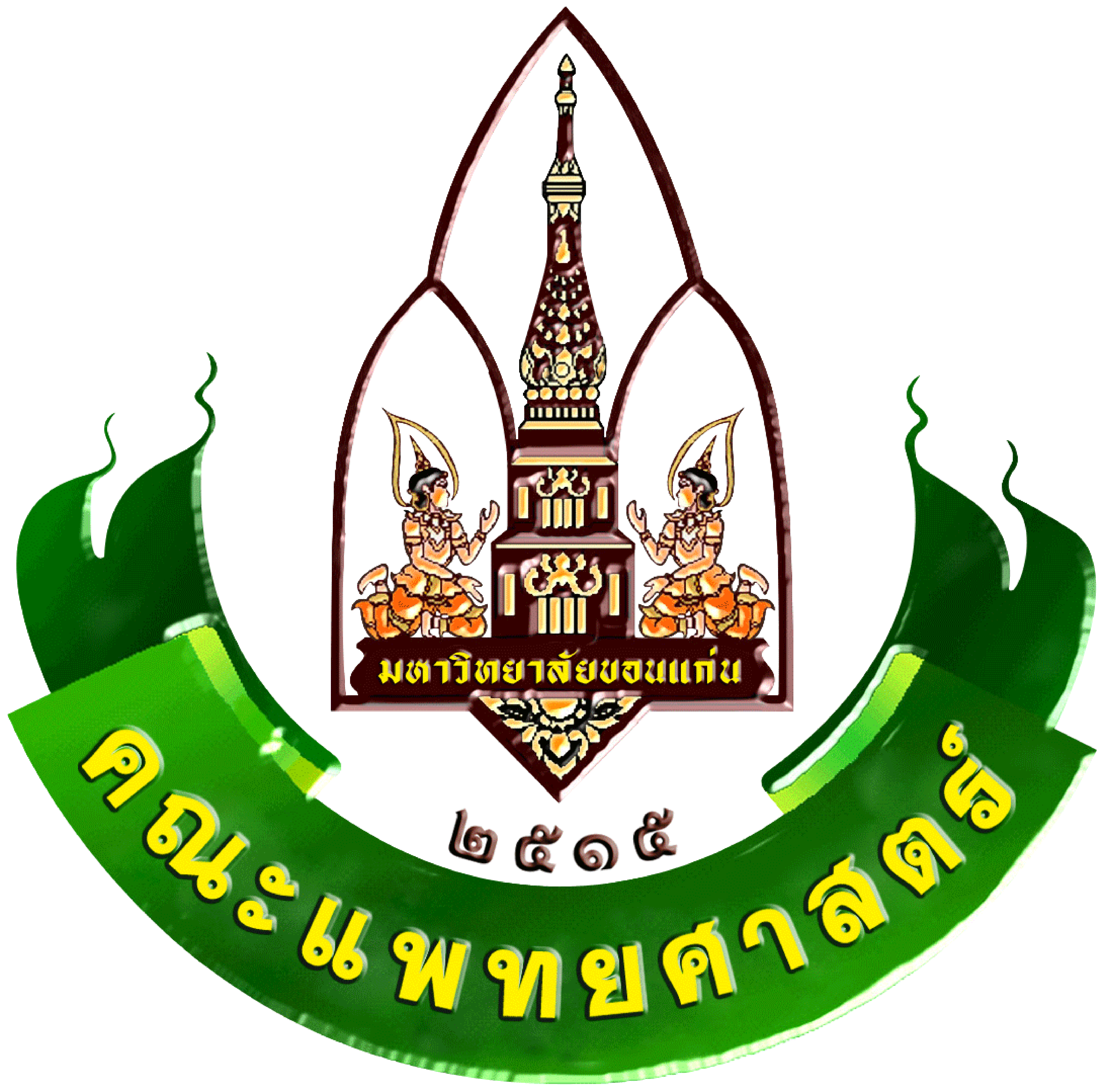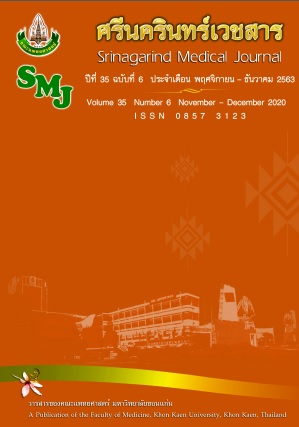ความสัมพันธ์ระหว่างความแปรปรวนของอัตราการเต้นของหัวใจ กับความบกพร่องทางระบบประสาทสั่งการและระดับความพิการในผู้ป่วยโรคหลอดเลือดสมองชนิดสมองขาดเลือดระยะเรื้อรัง
คำสำคัญ:
ความแปรปรวนของอัตราการเต้นของหัวใจ; โรคหลอดเลือดสมองชนิดสมองขาดเลือด; ความบกพร่องของระบบประสาทสั่งการ; ระดับความพิการบทคัดย่อ
หลักการและวัตถุประสงค์: ความบกพร่องของระบบประสาทอัตโนมัติที่ควบคุมหัวใจ ประเมินโดยค่าความแปรปรวนของอัตราการเต้นของหัวใจ (Heart rate variability: HRV) มีความสัมพันธ์กับความบกพร่องของระบบประสาทสั่งการรยางค์ในผู้ป่วยโรคหลอดเลือดสมองระยะเฉียบพลัน การศึกษาครั้งนี้มีวัตถุประสงค์เพื่อ ทดสอบความสัมพันธ์ระหว่าง HRV กับความบกพร่องของระบบประสาทสั่งการ และระดับความพิการในผู้ป่วยโรคหลอดเลือดสมองชนิดสมองขาดเลือดระยะเรื้อรัง
วิธีการศึกษา: อาสาสมัครโรคหลอดเลือดสมองระยะเรื้อรัง (6-72 เดือน) ถูกคัดเลือกเข้าร่วมการศึกษา โดยอาสาสมัครสามารถยืนเองอย่างน้อย 5 นาที และทำตามคำสั่ง 2 ขั้นตอนได้ ประเมิน HRV ในท่านอนหงาย เป็นเวลา 20 นาที ประเมินความบกพร่องของระบบประสาทสั่งการรยางค์ส่วนบนและส่วนล่าง และระดับความพิการ ด้วยแบบประเมิน Fugl-Meyer Assessment (FMA) และ Modified Rankin Scale (mRS) ตามลำดับ ทดสอบความสัมพันธ์ระหว่างตัวแปรโดยใช้สถิติ Spearman’s correlation coefficients ที่ระดับนัยสำคัญทางสถิติ p<0.05
ผลการศึกษา: ผลการศึกษาพบความสัมพันธ์เชิงบวกระดับปานกลาง ระหว่างความบกพร่องของระบบประสาทสั่งการรยางค์ส่วนบน (FMA-UEs) กับ อัตราส่วนความถี่ต่ำในหน่วยมาตรฐาน (LF (nu)) (r=0.622; p=0.02) และ อัตราส่วนความถี่ต่ำ (LF) ต่อความถี่สูง (HF) (LF/HF ratio) (r=0.561; p=0.04) นอกจากนี้ยังพบความสัมพันธ์เชิงลบระดับสูง ระหว่างค่า LF nu (r=-0.855; p<0.001) และ LF/HF ratio (r=-0.711; p=0.006) กับระดับความพิการ
สรุป: ความแปรปรวนของอัตราการเต้นของหัวใจในผู้ป่วยโรคหลอดเลือดสมองชนิดสมองขาดเลือดระยะเรื้อรังมีความสัมพันธ์กับความบกพร่องของระบบประสาทสั่งการรยางค์ส่วนบน และระดับความพิการ
References
2. Feigin VL, Krishnamurthi RV, Parmar P, Norrving B, Mensah GA, Bennett DA, et al. Update on the global burden of ischemic and hemorrhagic stroke in 1990-2013: The GBD 2013 Study. Neuroepidemiology 2015; 45: 161-176.
3. Al-Qudah ZA, Yacoub HA, Souayah N. Disorders of the autonomic nervous system after hemispheric cerebrovascular disorders: An Update. J Vasc Interv Neurol 2015; 8: 43-52.
4. Chen Z, Venkat P, Seyfried D, Chopp M, Yan T, Chen J. brain-heart interaction: cardiac complications after stroke. Circ Res 2017; 121: 451-468.
5. Katz-Leurer M, Shochina M. Heart rate variability (HRV) parameters correlate with motor impairment and aerobic capacity in stroke patients. NeuroRehabilitation 2005; 20: 91-95.
6. Fyfe L, Muller J, Alonso A, Folsom R, Gottesman F, Rosamond D, et al. heart rate variability and incident Stroke. Stroke 2016; 47: 1452-1458.
7. Xhyheri B, Manfrini O, Mazzolini M, Pizzi C, Bugiardini R. Heart rate variability today. Prog Cardiovasc Dis 2012; 55: 321-331.
8. Heaney LM. Cardiac and respiratory monitoring of acute stroke patients. Heart & lung: J Crit Care 1977; 6: 469-474.
9. Yperzeele L, van Hooff R-J, Nagels G, De Smedt A, De Keyser J, Brouns R. Heart rate variability and baroreceptor sensitivity in acute stroke: A Systematic Review. Int J Stroke 2015; 10: 796-800.
10. Fatisson J, Oswald V, Lalonde F. Influence diagram of physiological and environmental factors affecting heart rate variability. Heart Int 2016; 11(1): e32-e40. doi: 10.5301/heartint.5000232.
11. Graff B, Gasecki D, Rojek A, Boutouyrie P, Nyka W, Laurent S, et al. Heart rate variability and functional outcome in ischemic stroke: a multiparameter approach. J. hypertens 2013; 31: 1629-1636.
12. Francica JV, Bigongiari A, Mochizuki L, Scapini KB, Moraes OA, Mostarda C, et al. Cardiac autonomic dysfunction in chronic stroke women is attenuated after submaximal exercise test, as evaluated by linear and nonlinear analysis. BMC Cardiovasc Disord 2015; 15:105.
13. Zhao M, Guan L, Wang Y. The association of autonomic nervous system function with ischemic stroke and treatment strategies. Front Neurol 2020; 10: 1411. doi: 10.3389/fneur.2019.01411.
14. Sethi A, Callaway CW, Sejdic E, Terhorst L, Skidmore ER. Heart rate variability is associated with motor outcome 3-months after Stroke. J Stroke Cerebrovasc Dis 2016; 25: 129-135.
15. Cohen J. Statistical power analysis for the behavioral Sciences ed 2. Hillsdale. NJ: Lawrence Erlbaum Associates, 1988.
16. Gladstone DJ, Danells CJ, Black SE. The fugl-meyer assessment of motor recovery after stroke: a critical review of its measurement properties. Neurorehabil Neural Repair 2002; 16: 232-240.
17. Fugl-Meyer AR, Jaasko L, Leyman I, Olsson S, Steglind S. The post-stroke hemiplegic patient. a method for evaluation of physical performance. Scand J Rehabil Med 1975; 7: 13-31.
18. G Sulter , C Steen, J De Keyser. Use of the barthel index and modified rankin scale in acute stroke trials. Stroke 1999; 30(8): 1538-1541. doi: 10.1161/01.str.30.8.1538.
19. อภิชาต สุคนธสรรพ์.Cardiovascular medicine: The new balance. พิมพ์ครั้งที่ 1. เชียงใหม่: โรงพิมพ์ทริคธิงค์. 2555.
20. Duncan PW, Goldstein LB, Horner RD, Landsman PB, Samsa GP, Matchar DB. Similar motor recovery of upper and lower extremities after stroke. Stroke 1994; 25: 1181-1188.
21. Banks JL, Marotta CA. Outcomes Validity and Reliability of the Modified Rankin Scale: Implications for Stroke Clinical Trials. Stroke 2007; 38: 1091-1096.
22. Gujjar AR, Sathyaprabha TN, Nagaraja D, Thennarasu K, Pradhan N. Heart rate variability and outcome in acute severe stroke: role of power spectral analysis. Neurocrit Care 2004; 1: 347-353.
23. Kerman IA. Organization of brain somatomotor-sympathetic circuits. Exp Brain Res 2008; 187: 1-16.
24. Sequeira H, Viltart O, Ba-M’Hamed S, Poulain P. Cortical control of somato-cardiovascular integration: neuroanatomical studies. Brain Res. Bull 2000; 53: 87-93.
25. Song H-S. The effects of specific respiratory rates on heart rate and heart rate variability. Appl Psychophysiol Biofeedbac 2003; 28: 13-23.
26. Steffen PR, Austin T, DeBarros A, Brown T. The impact of resonance frequency breathing on measures of heart rate variability, blood pressure, and mood. Public Health Front 2017; 5: 222.
27. Levin CJ, Swoap SJ. The impact of deep breathing and alternate nostril breathing on heart rate variability: a human physiology laboratory. Adv Physiol Educ 2019; 43: 270-6.
28. Arad M, Abboud S, Radai MM, Adunsky A. Heart rate variability parameters correlate with functional independence measures in ischemic stroke patients. J Electrocardiol 2002; 35: 243-6.
29. Monge-Argilés J, Palacios Ortega F, Vila X, Prados J, Vicente J, Ortiz A, et al. Brainstem lesions decrease heart rate variability. Neurología 2000; 15: 158-63.
30. Adams Jr HP, Bendixen BH, Kappelle LJ, Biller J, Love BB, Gordon DL, et al. Classification of subtype of acute ischemic stroke. Definitions for use in a multicenter clinical trial. TOAST. Trial of Org 10172 in Acute Stroke Treatment. Stroke 1993; 24(1): 35-41.



